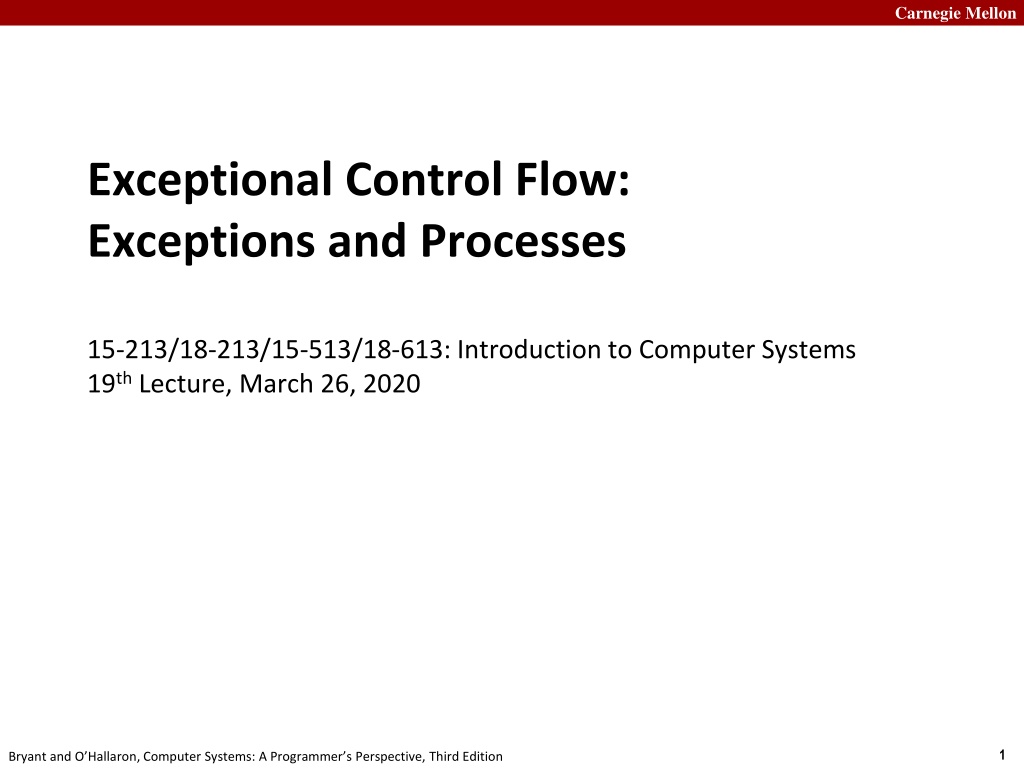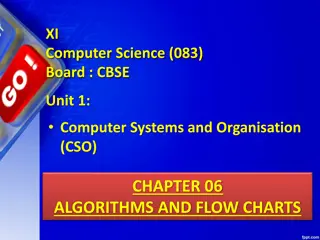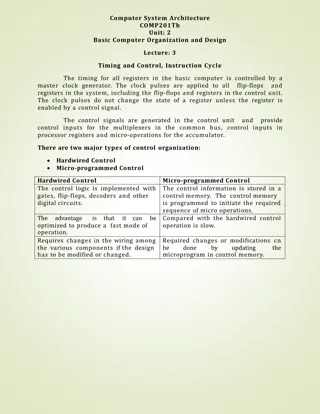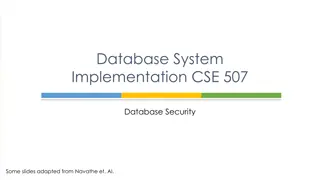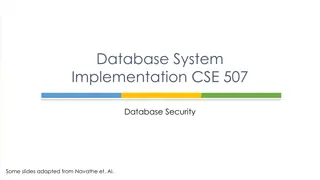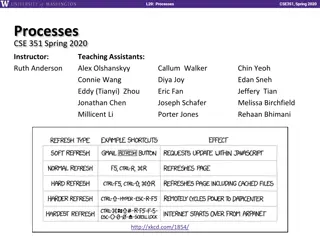Understanding Exceptional Control Flow in Computer Systems
Exceptional control flow in computer systems involves mechanisms such as exceptions, process context switches, signals, and nonlocal jumps to handle changes in system state or events. These mechanisms allow for efficient responses to events like data arriving from external sources, user interactions, system timer expirations, and more. It plays a crucial role in managing the flow of control from low-level hardware operations to high-level software processes.
Download Presentation

Please find below an Image/Link to download the presentation.
The content on the website is provided AS IS for your information and personal use only. It may not be sold, licensed, or shared on other websites without obtaining consent from the author. Download presentation by click this link. If you encounter any issues during the download, it is possible that the publisher has removed the file from their server.
E N D
Presentation Transcript
Carnegie Mellon Exceptional Control Flow: Exceptions and Processes 15-213/18-213/15-513/18-613: Introduction to Computer Systems 19thLecture, March 26, 2020 1 Bryant and O Hallaron, Computer Systems: A Programmer s Perspective, Third Edition
Carnegie Mellon Printers Used to Catch on Fire 2 Bryant and O Hallaron, Computer Systems: A Programmer s Perspective, Third Edition
Carnegie Mellon Highly Exceptional Control Flow https://git.kernel.org/pub/scm/linux/kernel/git/torvalds/linux.git/tree/drivers/char/lp.c?h=v5.0-rc3 3 Bryant and O Hallaron, Computer Systems: A Programmer s Perspective, Third Edition
Carnegie Mellon Today Exceptional Control Flow Exceptions Processes Process Control 4 Bryant and O Hallaron, Computer Systems: A Programmer s Perspective, Third Edition
Carnegie Mellon Control Flow Processors do only one thing: From startup to shutdown, a CPU simply reads and executes (interprets) a sequence of instructions, one at a time This sequence is the CPU s control flow (or flow of control) Physical control flow <startup> inst1 inst2 inst3 instn <shutdown> Time 5 Bryant and O Hallaron, Computer Systems: A Programmer s Perspective, Third Edition
Carnegie Mellon Altering the Control Flow Up to now: two mechanisms for changing control flow: Jumps and branches Call and return React to changes in program state Insufficient for a useful system: Difficult to react to changes in system state Data arrives from a disk or a network adapter Instruction divides by zero User hits Ctrl-C at the keyboard System timer expires System needs mechanisms for exceptional control flow 6 Bryant and O Hallaron, Computer Systems: A Programmer s Perspective, Third Edition
Carnegie Mellon Exceptional Control Flow Exists at all levels of a computer system Low level mechanisms 1. Exceptions Change in control flow in response to a system event (i.e., change in system state) Implemented using combination of hardware and OS software Higher level mechanisms 2. Process context switch Implemented by OS software and hardware timer 3. Signals Implemented by OS software 4. Nonlocal jumps: setjmp() and longjmp() Implemented by C runtime library 7 Bryant and O Hallaron, Computer Systems: A Programmer s Perspective, Third Edition
Carnegie Mellon Today Exceptional Control Flow Exceptions Processes Process Control 8 Bryant and O Hallaron, Computer Systems: A Programmer s Perspective, Third Edition
Carnegie Mellon Exceptions An exception is a transfer of control to the OS kernel in response to some event (i.e., change in processor state) Kernel is the memory-resident part of the OS Examples of events: Divide by 0, arithmetic overflow, page fault, I/O request completes, typing Ctrl-C User code Kernel code Exception Event I_current I_next Exception processing by exception handler Return to I_current Return to I_next Abort 9 Bryant and O Hallaron, Computer Systems: A Programmer s Perspective, Third Edition
Carnegie Mellon Exception Tables Exception numbers Each type of event has a unique exception number k Code for exception handler 0 Exception Table Code for exception handler 1 k = index into exception table (a.k.a. interrupt vector) 0 1 2 Code for exception handler 2 ... n-1 Handler k is called each time exception k occurs ... Code for exception handler n-1 10 Bryant and O Hallaron, Computer Systems: A Programmer s Perspective, Third Edition
Carnegie Mellon (Partial) Taxonomy ECF Asynchronous Synchronous Interrupts Traps Faults Aborts 11 Bryant and O Hallaron, Computer Systems: A Programmer s Perspective, Third Edition
Carnegie Mellon Asynchronous Exceptions (Interrupts) Caused by events external to the processor Indicated by setting the processor s interrupt pin Handler returns to next instruction Examples: Timer interrupt Every few ms, an external timer chip triggers an interrupt Used by the kernel to take back control from user programs I/O interrupt from external device Hitting Ctrl-C at the keyboard Arrival of a packet from a network Arrival of data from a disk 12 Bryant and O Hallaron, Computer Systems: A Programmer s Perspective, Third Edition
Carnegie Mellon Synchronous Exceptions Caused by events that occur as a result of executing an instruction: Traps Intentional, set program up to trip the trap and do something Examples: system calls, gdb breakpoints Returns control to next instruction Faults Unintentional but possibly recoverable Examples: page faults (recoverable), protection faults (unrecoverable), floating point exceptions Either re-executes faulting ( current ) instruction or aborts Aborts Unintentional and unrecoverable Examples: illegal instruction, parity error, machine check Aborts current program 13 Bryant and O Hallaron, Computer Systems: A Programmer s Perspective, Third Edition
Carnegie Mellon System Calls Each x86-64 system call has a unique ID number Examples: Number Name read write open close stat fork execve _exit kill Description 0 Read file 1 Write file 2 Open file 3 Close file 4 Get info about file 57 Create process 59 Execute a program 60 Terminate process 62 Send signal to process 14 Bryant and O Hallaron, Computer Systems: A Programmer s Perspective, Third Edition
Carnegie Mellon System Call Example: Opening File User calls: open(filename, options) Calls __open function, which invokes system call instruction syscall 00000000000e5d70 <__open>: ... e5d79: b8 02 00 00 00 mov $0x2,%eax # open is syscall #2 e5d7e: 0f 05 syscall # Return value in %rax e5d80: 48 3d 01 f0 ff ff cmp $0xfffffffffffff001,%rax ... e5dfa: c3 retq User code Kernel code %rax contains syscall number Other arguments in %rdi, %rsi, %rdx, %r10, %r8, %r9 Exception syscall cmp Return value in %rax Open file Negative value is an error corresponding to negative errno Returns 15 Bryant and O Hallaron, Computer Systems: A Programmer s Perspective, Third Edition
Carnegie Mellon System Call Example: Opening File Almost like a function call Transfer of control On return, executes next instruction Passes arguments using calling convention Gets result in %rax User calls: open(filename, options) Calls __open function, which invokes system call instruction syscall 00000000000e5d70 <__open>: ... e5d79: b8 02 00 00 00 mov $0x2,%eax # open is syscall #2 e5d7e: 0f 05 syscall # Return value in %rax e5d80: 48 3d 01 f0 ff ff cmp $0xfffffffffffff001,%rax ... e5dfa: c3 retq Different set of privileges And other differences: e.g., address of function is in %rax Uses errno Etc. One Important exception! Executed by Kernel User code Kernel code %rax contains syscall number Other arguments in %rdi, %rsi, %rdx, %r10, %r8, %r9 Exception syscall cmp Return value in %rax Open file Negative value is an error corresponding to negative errno Returns 16 Bryant and O Hallaron, Computer Systems: A Programmer s Perspective, Third Edition
Carnegie Mellon Fault Example: Page Fault int a[1000]; main () { a[500] = 13; } User writes to memory location That portion (page) of user s memory is currently on disk 80483b7: c7 05 10 9d 04 08 0d movl $0xd,0x8049d10 User code Kernel code Exception: page fault movl Copy page from disk to memory Return and reexecute movl 17 Bryant and O Hallaron, Computer Systems: A Programmer s Perspective, Third Edition
Carnegie Mellon Fault Example: Invalid Memory Reference int a[1000]; main () { a[5000] = 13; } 80483b7: c7 05 60 e3 04 08 0d movl $0xd,0x804e360 User code Kernel code Exception: page fault movl Detect invalid address Signal process Sends SIGSEGV signal to user process User process exits with segmentation fault 18 Bryant and O Hallaron, Computer Systems: A Programmer s Perspective, Third Edition
Carnegie Mellon Today Exceptional Control Flow Exceptions Processes Process Control 19 Bryant and O Hallaron, Computer Systems: A Programmer s Perspective, Third Edition
Carnegie Mellon Processes Definition: A process is an instance of a running program. One of the most profound ideas in computer science Not the same as program or processor Process provides each program with two key abstractions: Logical control flow Memory Stack Heap Data Each program seems to have exclusive use of the CPU Provided by kernel mechanism called context switching Private address space Code CPU Registers Each program seems to have exclusive use of main memory. Provided by kernel mechanism called virtual memory 20 Bryant and O Hallaron, Computer Systems: A Programmer s Perspective, Third Edition
Carnegie Mellon Multiprocessing: The Illusion Memory Memory Memory Stack Heap Data Stack Heap Data Stack Heap Data Code Code Code CPU Registers CPU Registers CPU Registers Computer runs many processes simultaneously Applications for one or more users Web browsers, email clients, editors, Background tasks Monitoring network & I/O devices 21 Bryant and O Hallaron, Computer Systems: A Programmer s Perspective, Third Edition
Carnegie Mellon Multiprocessing Example Running program top on Mac System has 123 processes, 5 of which are active Identified by Process ID (PID) 22 Bryant and O Hallaron, Computer Systems: A Programmer s Perspective, Third Edition
Carnegie Mellon Multiprocessing: The (Traditional) Reality Memory Stack Heap Data Stack Heap Data Stack Heap Data Code Code Saved registers Code Saved registers CPU Registers Single processor executes multiple processes concurrently Process executions interleaved (multitasking) Address spaces managed by virtual memory system (like last week) Register values for nonexecuting processes saved in memory 23 Bryant and O Hallaron, Computer Systems: A Programmer s Perspective, Third Edition
Carnegie Mellon Multiprocessing: The (Traditional) Reality Memory Stack Heap Data Stack Heap Data Stack Heap Data Code Saved registers Code Saved registers Code Saved registers CPU Registers Save current registers in memory 24 Bryant and O Hallaron, Computer Systems: A Programmer s Perspective, Third Edition
Carnegie Mellon Multiprocessing: The (Traditional) Reality Memory Stack Heap Data Stack Heap Data Stack Heap Data Code Saved registers Code Code Saved registers CPU Registers Schedule next process for execution 25 Bryant and O Hallaron, Computer Systems: A Programmer s Perspective, Third Edition
Carnegie Mellon Multiprocessing: The (Traditional) Reality Memory Stack Heap Data Stack Heap Data Stack Heap Data Code Saved registers Code Saved registers Code Saved registers CPU Registers Load saved registers and switch address space (context switch) 26 Bryant and O Hallaron, Computer Systems: A Programmer s Perspective, Third Edition
Carnegie Mellon Multiprocessing: The (Modern) Reality Memory Stack Heap Data Stack Heap Data Stack Heap Data Code Code Code Saved registers CPU Registers CPU Registers Multicore processors Multiple CPUs on single chip Share main memory (and some caches) Each can execute a separate process Scheduling of processors onto cores done by kernel 27 Bryant and O Hallaron, Computer Systems: A Programmer s Perspective, Third Edition
Carnegie Mellon Concurrent Processes Each process is a logical control flow. Two processes run concurrently (are concurrent) if their flows overlap in time Otherwise, they are sequential Examples (running on single core): Concurrent: A & B, A & C Sequential: B & C Process A Process B Process C Time 28 Bryant and O Hallaron, Computer Systems: A Programmer s Perspective, Third Edition
Carnegie Mellon User View of Concurrent Processes Control flows for concurrent processes are physically disjoint in time However, we can think of concurrent processes as running in parallel with each other Process A Process B Process C Time 29 Bryant and O Hallaron, Computer Systems: A Programmer s Perspective, Third Edition
Carnegie Mellon Context Switching Processes are managed by a shared chunk of memory- resident OS code called the kernel Important: the kernel is not a separate process, but rather runs as part of some existing process. Control flow passes from one process to another via a context switch Process A Process B user code context switch kernel code Time user code context switch kernel code user code 30 Bryant and O Hallaron, Computer Systems: A Programmer s Perspective, Third Edition
Carnegie Mellon Today Exceptional Control Flow Exceptions Processes Process Control 31 Bryant and O Hallaron, Computer Systems: A Programmer s Perspective, Third Edition
Carnegie Mellon System Call Error Handling On error, Linux system-level functions typically return -1 and set global variable errno to indicate cause. Hard and fast rule: You must check the return status of every system-level function Only exception is the handful of functions that return void Example: if ((pid = fork()) < 0) { fprintf(stderr, "fork error: %s\n", strerror(errno)); exit(-1); } 32 Bryant and O Hallaron, Computer Systems: A Programmer s Perspective, Third Edition
Carnegie Mellon Error-reporting functions Can simplify somewhat using an error-reporting function: void unix_error(char *msg) /* Unix-style error */ { fprintf(stderr, "%s: %s\n", msg, strerror(errno)); exit(-1); } Note: csapp.c exits with 0. if ((pid = fork()) < 0) unix_error("fork error"); But, must think about application. Not always appropriate to exit when something goes wrong 33 Bryant and O Hallaron, Computer Systems: A Programmer s Perspective, Third Edition
Carnegie Mellon Error-handling Wrappers We simplify the code we present to you even further by using Stevens1-style error-handling wrappers: pid_t Fork(void) { pid_t pid; if ((pid = fork()) < 0) unix_error("Fork error"); return pid; } pid = Fork(); NOT what you generally want to do in a real application 1e.g., in UNIX Network Programming: The sockets networking API W. Richard Stevens 34 Bryant and O Hallaron, Computer Systems: A Programmer s Perspective, Third Edition
Carnegie Mellon Obtaining Process IDs pid_t getpid(void) Returns PID of current process pid_t getppid(void) Returns PID of parent process 35 Bryant and O Hallaron, Computer Systems: A Programmer s Perspective, Third Edition
Carnegie Mellon Creating and Terminating Processes From a programmer s perspective, we can think of a process as being in one of three states Running Process is either executing, or waiting to be executed and will eventually be scheduled (i.e., chosen to execute) by the kernel Stopped Process execution is suspended and will not be scheduled until further notice (next lecture when we study signals) Terminated Process is stopped permanently 36 Bryant and O Hallaron, Computer Systems: A Programmer s Perspective, Third Edition
Carnegie Mellon Terminating Processes Process becomes terminated for one of three reasons: Receiving a signal whose default action is to terminate (next lecture) Returning from the main routine Calling the exit function void exit(int status) Terminates with an exit status of status Convention: normal return status is 0, nonzero on error Another way to explicitly set the exit status is to return an integer value from the main routine exit is called once but never returns 37 Bryant and O Hallaron, Computer Systems: A Programmer s Perspective, Third Edition
Carnegie Mellon Creating Processes Parent process creates a new running child process by calling fork int fork(void) Returns 0 to the child process, child s PID to parent process Child is almost identical to parent: Child get an identical (but separate) copy of the parent s virtual address space. Child gets identical copies of the parent s open file descriptors Child has a different PID than the parent fork is interesting (and often confusing) because it is called once but returns twice 38 Bryant and O Hallaron, Computer Systems: A Programmer s Perspective, Third Edition
Carnegie Mellon Conceptual View of fork Memory Memory parent child Stack Heap Data Stack Heap Data Stack Heap Data Code Code Code Saved registers Saved registers Saved registers CPU Registers CPU Registers Make complete copy of execution state Designate one as parent and one as child Resume execution of parent or child 39 Bryant and O Hallaron, Computer Systems: A Programmer s Perspective, Third Edition
Carnegie Mellon The fork Function Revisited VM and memory mapping explain how fork provides private address space for each process To create virtual address for new process: Create exact copies of current mm_struct, vm_area_struct, and page tables Flag each page in both processes as read-only Flag each vm_area_struct in both processes as private COW On return, each process has exact copy of virtual memory Subsequent writes create new pages using COW mechanism 40 Bryant and O Hallaron, Computer Systems: A Programmer s Perspective, Third Edition
Carnegie Mellon fork Example Call once, return twice int main(int argc, char** argv) { pid_t pid; int x = 1; Concurrent execution Can t predict execution order of parent and child pid = Fork(); if (pid == 0) { /* Child */ printf("child : x=%d\n", ++x); return 0; } /* Parent */ printf("parent: x=%d\n", --x); return 0; } fork.c linux> ./fork parent: x=0 child : x=2 linux> ./fork child : x=2 parent: x=0 linux> ./fork parent: x=0 child : x=2 linux> ./fork parent: x=0 child : x=2 41 Bryant and O Hallaron, Computer Systems: A Programmer s Perspective, Third Edition
Carnegie Mellon Making fork More Nondeterministic Problem Linux scheduler does not create much run-to-run variance Hides potential race conditions in nondeterministic programs e.g., does fork return to child first, or to parent? Solution Create custom version of library routine that inserts random delays along different branches e.g., for parent and child in fork Use runtime interpositioning to have program use special version of library code 42 Bryant and O Hallaron, Computer Systems: A Programmer s Perspective, Third Edition
Carnegie Mellon Variable delay fork /* fork wrapper function */ pid_t fork(void) { initialize(); int parent_delay = choose_delay(); int child_delay = choose_delay(); pid_t parent_pid = getpid(); pid_t child_pid_or_zero = real_fork(); if (child_pid_or_zero > 0) { /* Parent */ if (verbose) { printf( "Fork. Child pid=%d, delay = %dms. Parent pid=%d, delay = %dms\n", child_pid_or_zero, child_delay, parent_pid, parent_delay); fflush(stdout); } ms_sleep(parent_delay); } else { /* Child */ ms_sleep(child_delay); } return child_pid_or_zero; } myfork.c 43 Bryant and O Hallaron, Computer Systems: A Programmer s Perspective, Third Edition
Carnegie Mellon fork Example Call once, return twice int main(int argc, char** argv) { pid_t pid; int x = 1; Concurrent execution Can t predict execution order of parent and child Duplicate but separate address space x has a value of 1 when fork returns in parent and child Subsequent changes to x are independent pid = Fork(); if (pid == 0) { /* Child */ printf("child : x=%d\n", ++x); return 0; } /* Parent */ printf("parent: x=%d\n", --x); return 0; } Shared open files stdout is the same in both parent and child linux> ./fork parent: x=0 child : x=2 44 Bryant and O Hallaron, Computer Systems: A Programmer s Perspective, Third Edition
Carnegie Mellon Modeling fork with Process Graphs A process graph is a useful tool for capturing the partial ordering of statements in a concurrent program: Each vertex is the execution of a statement a -> b means a happens before b Edges can be labeled with current value of variables printf vertices can be labeled with output Each graph begins with a vertex with no inedges Any topological sort of the graph corresponds to a feasible total ordering. Total ordering of vertices where all edges point from left to right 45 Bryant and O Hallaron, Computer Systems: A Programmer s Perspective, Third Edition
Carnegie Mellon Process Graph Example int main(int argc, char** argv) { pid_t pid; int x = 1; child: x=2 printf parent: x=0 Child pid = Fork(); if (pid == 0) { /* Child */ printf("child : x=%d\n", ++x); return 0; } exit x==1 Parent exit main fork printf /* Parent */ printf("parent: x=%d\n", --x); return 0; } fork.c 46 Bryant and O Hallaron, Computer Systems: A Programmer s Perspective, Third Edition
Carnegie Mellon Interpreting Process Graphs Original graph: child: x=2 printf parent: x=0 exit x==1 exit main for k printf Feasible total ordering: Relabled graph: e f a b e c f d a b c d Infeasible total ordering: a b f c e d 47 Bryant and O Hallaron, Computer Systems: A Programmer s Perspective, Third Edition
Carnegie Mellon fork Example: Two Consecutive forks Bye printf Bye void fork2() { printf("L0\n"); fork(); printf("L1\n"); fork(); printf("Bye\n"); } L1 printf fork printf Bye printf Bye L1 L0 printf fork printf printf fork forks.c Feasible output: L0 L1 Bye Bye L1 Bye Bye Infeasible output: L0 Bye L1 Bye L1 Bye Bye 48 Bryant and O Hallaron, Computer Systems: A Programmer s Perspective, Third Edition
Carnegie Mellon fork Example: Nested forks in Parent void fork4() { printf("L0\n"); if (fork() != 0) { printf("L1\n"); if (fork() != 0) { printf("L2\n"); } } printf("Bye\n"); } Bye Bye printf printf L2 L0 L1 Bye printf printf fork printf printf fork Feasible output: L0 L1 Bye Bye L2 Bye Infeasible output: L0 Bye L1 Bye Bye L2 forks.c 49 Bryant and O Hallaron, Computer Systems: A Programmer s Perspective, Third Edition
Carnegie Mellon fork Example: Nested forks in Children void fork5() { printf("L0\n"); if (fork() == 0) { printf("L1\n"); if (fork() == 0) { printf("L2\n"); } } printf("Bye\n"); } L2 Bye printf Bye printf L1 printf fork printf L0 Bye printf printf fork Feasible output: L0 Bye L1 L2 Bye Bye Infeasible output: L0 Bye L1 Bye Bye L2 forks.c 50 Bryant and O Hallaron, Computer Systems: A Programmer s Perspective, Third Edition
